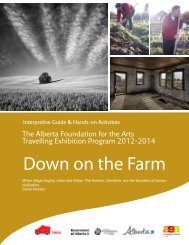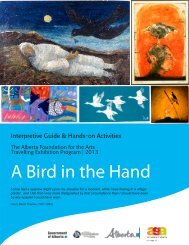Storytellers (PDF) - Art Gallery of Alberta
Storytellers (PDF) - Art Gallery of Alberta
Storytellers (PDF) - Art Gallery of Alberta
You also want an ePaper? Increase the reach of your titles
YUMPU automatically turns print PDFs into web optimized ePapers that Google loves.
Who doesn’t love a good story? Our entire lives are bound by the relating <strong>of</strong>events: what happened? where did it happen? how did it happen? who didit happen to? how did it end? These are the questions, and it is the answersto these questions, that teach us; that guide our relationships with others;and that form the memories we either cherish...or that haunt us to the end<strong>of</strong> our days.According to most historians and psychologists storytelling - the conveying<strong>of</strong> events in words, images and sounds - is one <strong>of</strong> the things that defineand bind humanity. Storytelling is a means for sharing and interpretingexperiences and has been used for millennia for entertainment, education,cultural preservation and to instill moral values. Storytelling is found in allhuman cultures and while most stories have been told orally or throughwritten text, they have also been expressed in visual forms for thousands <strong>of</strong>years.The relating <strong>of</strong> stories visually is called Narrative <strong>Art</strong>. In such artwork storiescan be told either as a moment in an ongoing story or as a sequence <strong>of</strong>events unfolding over time. Narrative works may depict grand or importantevents or ideas, expressed through the genre <strong>of</strong> History Paintings, or beconcerned with humble scenes or events from everyday life, articulated inGenre Scenes. Whatever the form <strong>of</strong> expression such representations containthe literary elements <strong>of</strong> setting, character, and narrative point <strong>of</strong> view. Mostimportantly, however, to be considered an actual story or involve narrativea visual art work must possess one crucial element: it must either imply oractually portray action.In 1971 the British musician Rod Stewart released the album EveryPicture Tells a Story and to a large degree he is correct - every picture does,in one way or another, tell a story. With artworks drawn from the collection<strong>of</strong> the <strong>Alberta</strong> Foundation for the <strong>Art</strong>s the exhibition <strong>Storytellers</strong> exploresthe narratives related by artists and the various ways they have beenportrayed.The exhibition <strong>Storytellers</strong> was curated by Shane Golby and organized bythe <strong>Art</strong> <strong>Gallery</strong> <strong>of</strong> <strong>Alberta</strong> for the <strong>Alberta</strong> Foundation for the <strong>Art</strong>s TravellingExhibition Program. The AFA Travelling Exhibition program is supported by the<strong>Alberta</strong> Foundation for the <strong>Art</strong>s.Cover Images:Top left image: Gerry Dotto, Speak <strong>of</strong> the Kettle, 2012, Colour photograph,Collection <strong>of</strong> the <strong>Alberta</strong> Foundation for the <strong>Art</strong>sTop right image: Bernard Bloom, Ecologically conscious student screaming atHomosexuals, 1994, Silver gelatin print toned on paper, Collection <strong>of</strong> the<strong>Alberta</strong> Foundation for the <strong>Art</strong>sBottom left image: Jacques Rioux, Newspaper Rock, Utah, 1992, Silvergelatin, selenium toned photograph on paper, Collection <strong>of</strong> the <strong>Alberta</strong>Foundation for the <strong>Art</strong>sBottom right image: Harry Savage, Postcard from a Green Trailer, 1972,Silkscreen on paper, Collection <strong>of</strong> the <strong>Alberta</strong> Foundation for the <strong>Art</strong>sThe <strong>Alberta</strong> Foundation for the <strong>Art</strong>s Travelling Exhibition ProgramTravelling Exhibition2013-2016 SeasonsThe <strong>Art</strong> <strong>Gallery</strong> <strong>of</strong> <strong>Alberta</strong> is pleased to present this travelling exhibitionfor the 2013-2016 season. Currently the <strong>Art</strong> <strong>Gallery</strong> <strong>of</strong> <strong>Alberta</strong> servesover 60 venues in approximately 35 communities. Exhibitions on tourfrom the <strong>Art</strong> <strong>Gallery</strong> <strong>of</strong> <strong>Alberta</strong> easily adapt to space requirements<strong>of</strong> smaller venues: schools, libraries, museums, health care centresand other community facilities. The exhibitions are organized in sucha manner as to make unpacking, packing, hanging and shipping aseasy as possible. Along with the exhibition, each venue receives anEducational Interpretive Guide. These materials enable teachers touse the exhibition within the school curriculum.The <strong>Alberta</strong> Foundation for the <strong>Art</strong>s Collection is the primary source<strong>of</strong> works featured in the travelling exhibitions. Other sources forexhibitions may include community partners, archives, privatecollections and loans from artists. Each year we welcome new venuesto enrich their community art through the <strong>Alberta</strong> Foundation for the<strong>Art</strong>s Travelling Exhibition Program.Our ThanksThe <strong>Alberta</strong> Foundation for the <strong>Art</strong>sand to the many individuals, organizations and communities whocontribute to the success <strong>of</strong> the <strong>Alberta</strong> Foundation for the <strong>Art</strong>sTravelling Exhibition Program each year.ContactShane Golby, Manager/CuratorAFA Travelling Exhibition Program Region 2<strong>Art</strong> <strong>Gallery</strong> <strong>of</strong> <strong>Alberta</strong>/CSF10550-107 StreetEdmonton, AB T5H 2Y6T: 780.428.3830F: 780.421.0479shane.golby@youraga.caThe <strong>Alberta</strong> Foundation for the <strong>Art</strong>sTravelling Exhibition Program...We need stories to provide us with a sense <strong>of</strong> wonder, to help uslearn courage and compassion, to affirm and connect us to life.George Webber, artist
Jeff BurgessWedding, 1981Oil on watercolour boardCollection <strong>of</strong> the <strong>Alberta</strong>Foundation for the <strong>Art</strong>sRoy KiyookaUntitled, Highlights, December 1951,Vol. 5, No. 3, 1951Lithograph on paperCollection <strong>of</strong> the <strong>Alberta</strong> Foundationfor the <strong>Art</strong>sMark TraficanteAuntie Josephine’s Wedding circa1980, 2012Acrylic on paperCollection <strong>of</strong> the <strong>Alberta</strong>Foundation for the <strong>Art</strong>sNarrative <strong>Art</strong> - art works which portray an actual story or part(s) <strong>of</strong>a story - is expressed within two main genre <strong>of</strong> painting. One focusconcerns Genre Paintings or Genre Scenes. Such works concern pictorialrepresentations in any media that portray scenes or events from everydaylife.Works <strong>of</strong> art classified as genre paintings focus on the mundane incidents<strong>of</strong> everyday life, depicting people the viewer can easily identify withengaged in situations that tell a story. Over the centuries artists haveexplored a number <strong>of</strong> themes in genre paintings. Work and leisureactivities have been very popular sources <strong>of</strong> inspiration and such works<strong>of</strong>ten create a nostalgia for good times remembered or an ideal worldwhere life is less complicated. In the hands <strong>of</strong> some modern artists,however, such scenes serve as windows on the ‘grittier’ sides <strong>of</strong> life.Jeff Burgess’s painting Wedding <strong>of</strong> 1981 is an example <strong>of</strong> a genre scene,depicting as it does a very common activity; a couple leaving a churchafter their wedding ceremony. While portraying what is usually perceivedas a very happy event, however, Burgess’s style <strong>of</strong> presentation imbuesthis event with a disturbing air. As expressed by the artist:My work almost always deals with the human figure and portraitureas I feel a need in art to return to the representation <strong>of</strong> it. I am keenlyinterested in the human anatomy, the shapes and textures <strong>of</strong> skin andmuscles and how far one can stretch and distort them beyond the actual.The unsettling distortions and use <strong>of</strong> colour evident in the figuresportrayed in Wedding link Burgess’s style to that <strong>of</strong> expressionism.Developed during the late 19 th century, expressionism proclaimed thedirect rendering <strong>of</strong> emotions and feelings as the only true goal <strong>of</strong> art andthrough colour and linear distortions expressionist artists attempted toexpress the elemental emotions <strong>of</strong> anxiety, fear, love and hatred. Usingheightened colour and exaggerated modeling in his figures, Burgesstransforms the wedding party and guests from happy revellers intoleering ‘monsters’ or animals and changes a normally celebratory rite<strong>of</strong> commitment into a rather unpleasant and perhaps even sinisterspectacle.Narrative art is also expressed through the genre <strong>of</strong> History Paintings whichare defined by subject matter rather than artistic style. From the fifteenthto nineteenth centuries history painting was considered the highest form <strong>of</strong>Western painting, occupying the most prestigious place in the hierarchy <strong>of</strong>artistic genres.History painting is not simply the painting <strong>of</strong> history but includes thedepiction <strong>of</strong> events that may or may not have happened. Because <strong>of</strong> this, itcould be more accurately called narrative painting. The term history paintingderives from the Latin historia and essentially means ‘story painting’. Assuch, history paintings are distinct from other kinds <strong>of</strong> paintings that do nottell a story at all, such as portraiture or still life paintings.From around 1400 artists began to turn to the classical worlds <strong>of</strong> Greeceand Rome for inspiration. <strong>Art</strong>ists either used classical stories or myths assubjects for their work or artists and patrons chose a theme and then soughtout suitable stories or adapted mythologies to suit their needs.This interest in classicism has survived the centuries and one classicalstory expressed in the exhibition <strong>Storytellers</strong> is seen in the lithograph byRoy Kiyooka. Kiyooka’s humorous modernist drawing references the Greekmyth <strong>of</strong> Pygmalion. According to legend Pygmalion was a sculptor in Cypruswho created a statue <strong>of</strong> a beautiful woman and fell in love with his work.Pygmalion made <strong>of</strong>ferings at the altar <strong>of</strong> Venus where he prayed that hissculpture would be changed into a real woman. When he returned home hekissed the sculpture and found that his wish had been granted: she changedinto a real woman and Pygmalion married his living sculpture with Venus’blessing.In Kiyooka’s print from Highlights the beautiful woman <strong>of</strong> the Pygmalionstory is changed into an abstract figurative sculpture. In the work sculptorand sculpture toast the artist’s success in bringing the work to life, perhapsspeaking not only to the skill <strong>of</strong> the artist illustrated in the work, but also tothe ‘birth’ and perceived triumph <strong>of</strong> modernist abstraction at the time.A classification <strong>of</strong> art which usually falls within the realm <strong>of</strong> genre scenesis that <strong>of</strong> Outsider <strong>Art</strong>. In the exhibition <strong>Storytellers</strong> characteristics <strong>of</strong>Outsider <strong>Art</strong> are seen in the painting Auntie Josephine’s Wedding circa1980 by Mark Traficante.The term Outsider <strong>Art</strong> was developed in 1972 as an English synonym forart brut, a term created by French artist Jean Dubuffet to describe artcreated by those outside <strong>of</strong> the established art scene. In Dubuffet’sdefinition, art brut was quite specific in nature and referred to art createdby inmates <strong>of</strong> mental institutions or by children. The English term‘outsider art’ is <strong>of</strong>ten applied quite broadly to include certain self-taughtor nave artists who were never institutionalized. One <strong>of</strong> the mostcommon terms to describe the work <strong>of</strong> such artists is Naïve art.Generally speaking the characteristics <strong>of</strong> nave art are an awkwardrelationship to the formal qualities <strong>of</strong> painting. Such artists especiallyignore the three rules <strong>of</strong> perspective which are:1/ a decrease in the size <strong>of</strong> objects proportionally at the distance2/ a decrease in the vividness <strong>of</strong> colours with the distance3/ a decrease in the precision <strong>of</strong> details with the distanceIn ignoring these rules Nave artists <strong>of</strong>ten create works where:1/ the effects <strong>of</strong> perspective are geometrically erroneous2/ there is a strong use <strong>of</strong> pattern and an unrefined use <strong>of</strong> colour on allthe planes <strong>of</strong> the composition3/ equal accuracy is brought to details, including those <strong>of</strong> thebackground (which should be shaded <strong>of</strong>f and less defined with distance)Mark Traficante, a client at The Nina Haggerty Centre for the <strong>Art</strong>s inEdmonton, demonstrates many <strong>of</strong> the above characteristics <strong>of</strong> naive artin his painting Aunt Josephine’s Wedding.... While there are tonal changesin colour to create a shallow sense <strong>of</strong> space in the work, there is anoverall consistency in the accuracy <strong>of</strong> details between backgroundobjects and the foreground figures, a strong use <strong>of</strong> patterning, and anawkwardness in proportion in the rendering <strong>of</strong> the figures. Rather thandetracting from the presentation, however, such an honest treatmentprovides the story being related with a freshness and sense <strong>of</strong> immediacyand serves as an informative contrast to Jeff Burgess’s interpretation <strong>of</strong> asimilar celebration.
















